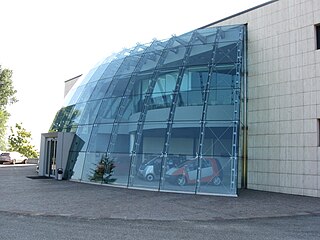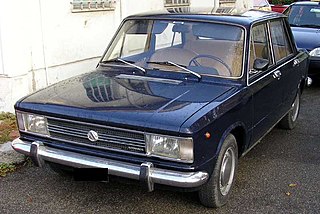
Abarth & C. S.p.A. is an Italian racing and road car maker and performance division founded by Italo-Austrian Carlo Abarth in 1949. Abarth & C. S.p.A. is owned by Stellantis through its Italian subsidiary. Its logo is a shield with a stylized scorpion on a yellow and red background.

Autobianchi was an Italian automobile manufacturer, created jointly by Bianchi, Pirelli and Fiat in 1955. Autobianchi produced only a handful of models during its lifetime, which were almost exclusively small cars, with the biggest being the short-lived Autobianchi A111, a small family car. Autobianchis were priced higher than Fiat models of similar size and the brand was used by Fiat to test innovative concepts which later found their way into mainstream Fiat vehicles; these concepts included fibreglass bodies and front-wheel drive.

The Fiat 1100 is a small family car produced from 1953 until 1969 by the Italian manufacturer Fiat. It was an all-new unibody replacement for the Fiat 1100 E, which descended from the pre-war, body-on-frame Fiat 508 C Balilla 1100. The 1100 was changed steadily and gradually until being replaced by the new Fiat 128 in 1969. There were also a series of light commercial versions of the 1100 built, with later models called the Fiat 1100T, which remained in production until 1971. The Fiat 1100 D also found a long life in India, where Premier Automobiles continued to build the car until the end of 2000.

Pininfarina S.p.A. is an Italian car design firm and coachbuilder, with headquarters in Cambiano, Turin, Italy. It was founded by Battista "Pinin" Farina in 1930. On 14 December 2015, the Indian multinational giant Mahindra Group acquired 76.06% of Pininfarina S.p.A. for about €168 million.

The Autobianchi A112 is a supermini produced by the Italian automaker Autobianchi. It was developed using a shrunken version of the contemporary Fiat 128's platform. The mechanicals of the A112 subsequently underpinned the Fiat 127. It was introduced in November 1969, as a replacement for the Bianchina and Primula, and was built until 1986, when it made way for the more modern Autobianchi Y10. Over 1.2 million A112s were produced in Autobianchi's Milan factory.

Franco Scaglione was an automobile coachwork designer.

Dante Giacosa was an Italian automobile designer and engineer responsible for a range of Italian automobile designs — and for refining the front-wheel drive layout to an industry-standard configuration.

The Autobianchi A111 is a 4-door saloon family car produced from 1969 to 1972 by Italian car manufacturer Autobianchi, a subsidiary of the Fiat group. Despite rather modest dimensions, at roughly 4 metres long, it was the largest Autobianchi ever made, as the brand specialized in small cars. A modern front-wheel drive construction like the Fiat 128 launched concurrently, it was based on the revolutionary Autobianchi Primula, Fiat's first "experiment" with the transverse engine front-wheel-drive setup.

The Autobianchi Stellina is a small spider from the Italian automaker, Autobianchi, built for only two years, 1964 and 1965. It was based on the mechanicals of the chassis Fiat 600D, but had a unique unibody structure, with the outside panels made of fibreglass reinforced plastics, based on a steel frame. It was the first Italian car with a fibreglass body, and one of the first in the world. Powered by Fiat 600D's rear-mounted, water-cooled 767 cc straight-4 engine, delivering 29 hp (22 kW), the Stellina had drum brakes on all four wheels.

The Fiat 8V is a V8-engined sports car produced by the Italian car manufacturer Fiat from 1952 to 1954. The car was introduced at the 1952 Geneva Motor Show. The Fiat 8V got its name because at the time of its making, Fiat believed Ford had a copyright on "V8". With 114 made, the 8V wasn't a commercial success, but did well in racing. Apart from the differential the car did not share any parts with the other Fiats. The 8V was developed by Dante Giacosa and the stylist Luigi Rapi. The engine was a V8 originally designed for a luxury sedan, but that project was stopped.
Tom Tjaarda was an American automobile designer noted for his work on a broad range of automobiles — estimated at over eighty — from exotic sports cars including the Ferrari 365 California, De Tomaso Pantera and Aston Martin Lagonda Coupé to high-volume popular cars including the first generation Ford Fiesta (1972) and the Fiat 124 Spider (1966).
The Turin Motor Show was an auto show held annually in Turin, Italy. The first official show took place between 21 and 24 April 1900, at the Castle of Valentino, becoming a permanent fixture in Turin from 1938 having shared it with Milan and Rome until that time. From 1972, the show was held biannually and in 1984, it moved into Fiat's shuttered Lingotto factory.
F.I.V. Edoardo Bianchi S.p.A., commonly known as Bianchi is the world's oldest bicycle manufacturing company in existence, having pioneered the use of equal-sized wheels with pneumatic rubber tires. The company was founded in Italy in 1885 and in addition to bicycles it produced motorcycles from 1897 to 1967. In 1955 the joint-venture Autobianchi was created together with Fiat and Pirelli for the manufacturing of cars – Autobianchi was subsequently sold to Fiat in 1969.

Fiat 1200 was the name of three distinct models produced by Italian car manufacturer Fiat, all based on Fiat 1100 mechanicals. The first two were introduced in 1957, and replaced the TV variants at the top of the Fiat 1100 range: the 1200 Granluce, an upmarket small four-door saloon derived from the 1100, and the 1200 Spyder, an update of the previous 1100 TV Trasformabile 2-door roadster. The 1200 Granluce was discontinued in 1961 when larger Fiat saloons were introduced, while the 1200 Trasformabile/Spyder was replaced in 1959 by the 1200 Cabriolet. This was a new Pininfarina design, later developed into the 1200 and 1500 Cabriolets.

The Stabilimento di Mirafiori is the headquarters and industrial district of the Italian automobile manufacturer Fiat, a subsidiary of FCA Italy, which is part of Stellantis, and is the headquarters of CNH Industrial Group.

Progetto K Automodelli, or sometimes simply referred to as PK ("Project K" in English), was an Italian diecast model company. Brands produced were usually Italian cars of the 1950s through the 1970s. Most models were diecast in plastic or resin – some had diecast bases and some were plastic. Though earlier models were made in Rome, the company's main factory was eventually moved to Sesto Fiorentino, a village just to the north of Florence in Firenze. The first models were made about 1977; the last about 2011.

The Fiat Pininfarina Cabriolet was a two-door, two passenger, front engine rear drive convertible manufactured by Pininfarina, and marketed by Fiat across two generations, superseding the Fiat 1200 Spyder.

The Autobianchi A112 Runabout is a concept car developed by Bertone and first shown in 1969. The small two-seat, mid-engined car was the inspiration for the Fiat X1/9 that appeared in 1972.



















